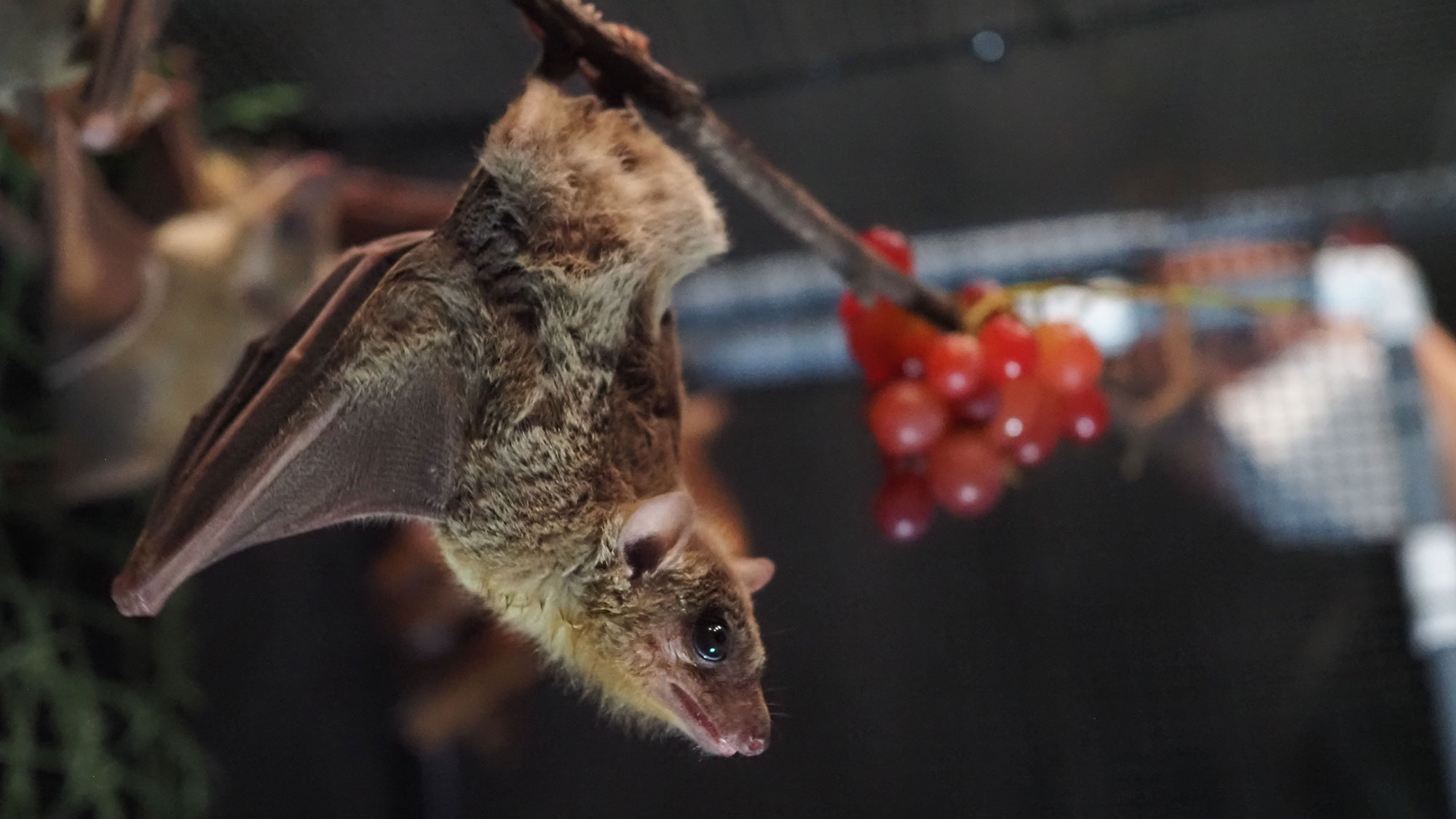What bats can teach us about the evolution of human speech
The part of bats’ brains that controls vocalizations has the same neural and genetic machinery as the part of the human brain that controls speech, new study finds.

Julie E. Elie and Boaz Styr/UC Berkeley
February 29, 2024
Human speech has always been an oddity within the animal kingdom. Only a handful of other animals, including bats, whales, seals, elephants and some birds, such as songbirds or parrots, exhibit vocalizations that start to approach the complexity of human speech.
With few close mammalian relatives sharing the gift of gab — which researchers call vocal learning — scientists have struggled to identify the neural and genetic underpinnings of this remarkable skill.
In a paper published today in the journal Science, a team led by scientists at the University of California, Berkeley, and Carnegie Mellon University identified the part of the brain in Egyptian fruit bats that controls vocalizations and found that it contains very similar neural wiring to the part of the human brain that controls speech.
The team then compared the genetic machinery in this part of the bat’s brain with the genomes of hundreds other mammals and, with the help of machine learning, identified a series of genetic regulatory elements that are highly associated with vocal learning in humans and other mammals.
Some of these genetic elements have previously been linked to human speech disabilities, including autism spectrum disorder. By understanding the genetic, neural and evolutionary bases of vocal learning in bats and other mammals, the researchers hope to shed light on other types of speech pathology.
“Very few mammals are actually capable of learning the sounds that they make, which makes it very difficult to study this core aspect of humanity,” said study co-corresponding author Michael Yartsev, an associate professor of bioengineering and neuroscience at UC Berkeley. “We were able to identify parallels between bats and humans in the structural elements of the brain, the genetic content, and even the neural circuitry that control vocal learning.”
The brain’s vocal ‘puppeteer’
To identify the areas of the bat brain associated with vocal learning, study co-first authors Julie E. Elie and Tobias Schmid, working in Yartsev’s Neurobat Lab at UC Berkeley, used wireless recording devices to “listen in” on the brains of a group of Egyptian fruit bats as they freely vocalized. The researchers then used molecular tracers to visualize how these neurons connected with other areas of the bat’s brains.
The tracing experiments highlighted a direct neural link between the motor cortex and the neurons that control the larynx, or voice box, in the bats. This direct neural connection acts like a vocal “puppeteer” and would give bats precise control over the pitch of their calls.
Similar connections have been observed in songbirds and humans, but not in other mammals or primates.
Courtesy of the Neurobat Lab
“This hypothesis is that when you are a vocal learner, you are expected to have this connection,” Elie said. “Before this study, scientists were comparing humans and birds, which are very far from each other on the evolutionary tree. With this paper, we are now zooming in on mammals and finding similar correlates of vocal learning — these direct projection neurons and the genetic machinery that goes with them — in the brains of bats.”
Study co-first author Morgan Wirthlin and co-corresponding author Andreas Pfenning, an associate professor of computational biology at Carnegie Mellon University, then used a machine learning approach called TACIT to analyze the genetic elements in the areas of the bat brain associated with vocal production. When they compared these genetic elements with those of 222 other mammals — both vocal learners and non-vocal learners — they identified 50 gene regulatory elements that are highly correlated among vocal learners, including humans, bats, whales and seals. Regulatory elements are DNA sequences outside the actual genes that direct which genes are active in particular tissues.
“We found that the types of cells that form long range connections in the human and bat brain are the same ones that we discovered as most relevant to vocal learning based on the genetic analysis,” Pfenning said. “The anatomy and genetics are both pointing to the same mechanism underlying the evolution of vocal learning across mammals and speech production in humans.”
Additional co-authors include Xiaomeng Zhang, Irene M. Kaplow, Daniel E. Schäffer, Alyssa J. Lawler and Siddharth Annaldasula of Carnegie Mellon University; Varvara A. Shvareva, Ashley Rakuljic, Maria B. Ji and Ninad S. Bhat of UC Berkeley; Byungkook Lim of the University of California, San Diego; Eiman Azim of the Salk Institute for Biological Sciences; Wynn K. Meyer of Lehigh University; and the Zoonomia Consortium.
This research was supported by the Alfred P. Sloan Foundation (FG-2017-9646), the National Institutes of Health (NIDA DP1DA046585, R01NS111479, R01 NS121231, DP2 DP2-DC016164), the National Science Foundation (NSF IOS-2022241, TG- BIO200055), The New York Stem Cell Foundation, the Brain Research Foundation (BRFSG-2017-09), the Packard Foundation (2017-66825), a Klingestein-Simons Fellowship, the Human Frontiers Research Program, the Pew Charitable trust (00029645), the McKnight Foundation (042823) and the Dana Foundation.
RELATED INFORMATION